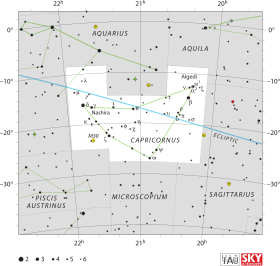Nu Capricorni or ν Capricorni is a binary star[4] system in the southern constellation of Capricornus. It is visible to the naked eye with an apparent visual magnitude of +4.76.[2]
Location of ν Capricorni (circled), to the ESE of the naked eye double, α Capricorni | |
| Observation data Epoch J2000.0 Equinox J2000.0 (ICRS) | |
|---|---|
| Constellation | Capricornus |
| Right ascension | 20h 20m 39.81562s[1] |
| Declination | −12° 45′ 32.6844″[1] |
| Apparent magnitude (V) | +4.76[2] |
| Characteristics | |
| Spectral type | B9 IV[3] or B9.5 V[4] |
| U−B color index | −0.11[2] |
| B−V color index | −0.04[2] |
| Astrometry | |
| Radial velocity (Rv) | −1.00[5] km/s |
| Proper motion (μ) | RA: +14.74[1] mas/yr Dec.: −14.32[1] mas/yr |
| Parallax (π) | 12.88 ± 0.27 mas[1] |
| Distance | 253 ± 5 ly (78 ± 2 pc) |
| Absolute magnitude (MV) | +0.32[6] |
| Details | |
| ν Cap A | |
| Mass | 2.37[7] M☉ |
| Luminosity | 87[6] L☉ |
| Surface gravity (log g) | 3.97[7] cgs |
| Temperature | 10,461±356[7] K |
| Metallicity [Fe/H] | −0.15±0.04[6] dex |
| Rotational velocity (v sin i) | 24[8] km/s |
| Age | 115[7] Myr |
| Other designations | |
| Database references | |
| SIMBAD | data |
Attributes
editThe star system is 6.6 degrees north of the ecliptic and so is within the margin of occultations of few if any planets but is well within that of the Moon.[10] The celestial latitude of either of the Alpha Capricorni main stars is about 6.93 degrees by comparison.[11] The system is calculated to be a distance of 253 light-years from the Sun based on parallax.
The two components are designated Nu Capricorni A and B. Component A is formally named Alshat /ˈælʃæt/, the traditional name for the system)[12]
The primary, component A, is a blue-white hued B-type main-sequence or subgiant star with an apparent magnitude of +4.77. Component B is a magnitude 11.8 star at an angular separation of 54.1 arcseconds from the primary.[4] Gaia Data Release 2 shows the companion to be much further away from Earth.[13]
Nomenclature
editν Capricorni, Latinised to Nu Capricorni, is the system's Bayer designation. The designations of the two components as Nu Capricorni A and B derive from the convention used by the Washington Multiplicity Catalog (WMC) for multiple star systems, and adopted by the International Astronomical Union (IAU).[14]
The system bore the traditional name Alshat, from the Arabic الشاة aš-šā[t], meaning 'the sheep' that was to be slaughtered by the adjacent Beta¹ Capricorni (Dabih).[15] In 2016, the IAU organized a Working Group on Star Names (WGSN)[16] to catalog and standardize proper names for stars. The WGSN decided to attribute proper names to individual stars rather than entire multiple systems.[17] It approved the name Alshat for the component Nu Capricorni A on 30 June 2017 and it is now so included in the List of IAU-approved Star Names.[12]
References
edit- ^ a b c d e van Leeuwen, F. (2007), "Validation of the new Hipparcos reduction", Astronomy and Astrophysics, 474 (2): 653–664, arXiv:0708.1752, Bibcode:2007A&A...474..653V, doi:10.1051/0004-6361:20078357, S2CID 18759600.
- ^ a b c d Johnson, H. L.; et al. (1966), "UBVRIJKL photometry of the bright stars", Communications of the Lunar and Planetary Laboratory, 4 (99): 99, Bibcode:1966CoLPL...4...99J.
- ^ Houk, N.; Smith-Moore, M. (1988), Michigan Catalogue of Two-dimensional Spectral Types for the HD Stars, vol. 4, Bibcode:1988mcts.book.....H.
- ^ a b c Eggleton, P. P.; Tokovinin, A. A. (September 2008), "A catalogue of multiplicity among bright stellar systems", Monthly Notices of the Royal Astronomical Society, 389 (2): 869–879, arXiv:0806.2878, Bibcode:2008MNRAS.389..869E, doi:10.1111/j.1365-2966.2008.13596.x, S2CID 14878976.
- ^ Gontcharov, G. A. (November 2006), "Pulkovo Compilation of Radial Velocities for 35495 Hipparcos stars in a common system", Astronomy Letters, 32 (11): 759–771, arXiv:1606.08053, Bibcode:2006AstL...32..759G, doi:10.1134/S1063773706110065, S2CID 119231169.
- ^ a b c Anderson, E.; Francis, Ch. (2012), "XHIP: An extended hipparcos compilation", Astronomy Letters, 38 (5): 331, arXiv:1108.4971, Bibcode:2012AstL...38..331A, doi:10.1134/S1063773712050015, S2CID 119257644.
- ^ a b c d David, Trevor J.; Hillenbrand, Lynne A. (2015), "The Ages of Early-Type Stars: Strömgren Photometric Methods Calibrated, Validated, Tested, and Applied to Hosts and Prospective Hosts of Directly Imaged Exoplanets", The Astrophysical Journal, 804 (2): 146, arXiv:1501.03154, Bibcode:2015ApJ...804..146D, doi:10.1088/0004-637X/804/2/146, S2CID 33401607.
- ^ Royer, F.; et al. (February 2007), "Rotational velocities of A-type stars. III. Velocity distributions", Astronomy and Astrophysics, 463 (2): 671–682, arXiv:astro-ph/0610785, Bibcode:2007A&A...463..671R, doi:10.1051/0004-6361:20065224, S2CID 18475298.
- ^ "nu. Cap". SIMBAD. Centre de données astronomiques de Strasbourg. Retrieved 2017-05-13.
{{cite web}}: CS1 maint: postscript (link) - ^ White, Nathaniel M.; Feierman, Barry H. (September 1987), "A Catalog of Stellar Angular Diameters Measured by Lunar Occultation", Astronomical Journal, 94: 751, Bibcode:1987AJ.....94..751W, doi:10.1086/114513.
- ^ "Zodiac Stars".
- ^ a b "Naming Stars". IAU.org. Retrieved 16 December 2017.
- ^ Brown, A. G. A.; et al. (Gaia collaboration) (August 2018). "Gaia Data Release 2: Summary of the contents and survey properties". Astronomy & Astrophysics. 616. A1. arXiv:1804.09365. Bibcode:2018A&A...616A...1G. doi:10.1051/0004-6361/201833051. Gaia DR2 record for this source at VizieR.
- ^ Hessman, F. V.; Dhillon, V. S.; Winget, D. E.; Schreiber, M. R.; Horne, K.; Marsh, T. R.; Guenther, E.; Schwope, A.; Heber, U. (2010). "On the naming convention used for multiple star systems and extrasolar planets". arXiv:1012.0707 [astro-ph.SR].
- ^ Allen, R. H. (1963). Star Names: Their Lore and Meaning (Reprint ed.). New York: Dover Publications Inc. p. 142. ISBN 0-486-21079-0. Retrieved 2010-12-12.
- ^ "IAU Working Group on Star Names (WGSN)". Retrieved 22 May 2016.
- ^ "WG Triennial Report (2015-2018) - Star Names" (PDF). p. 5. Retrieved 2018-07-14.
